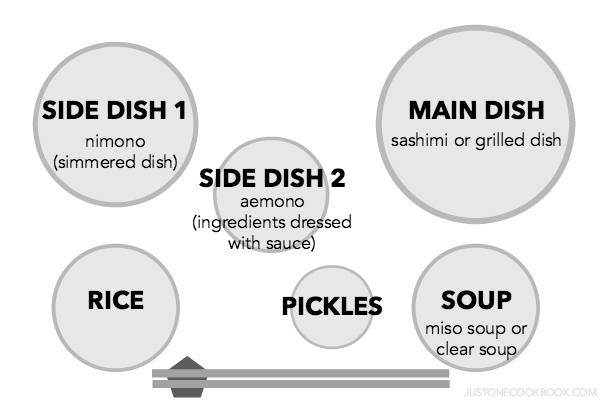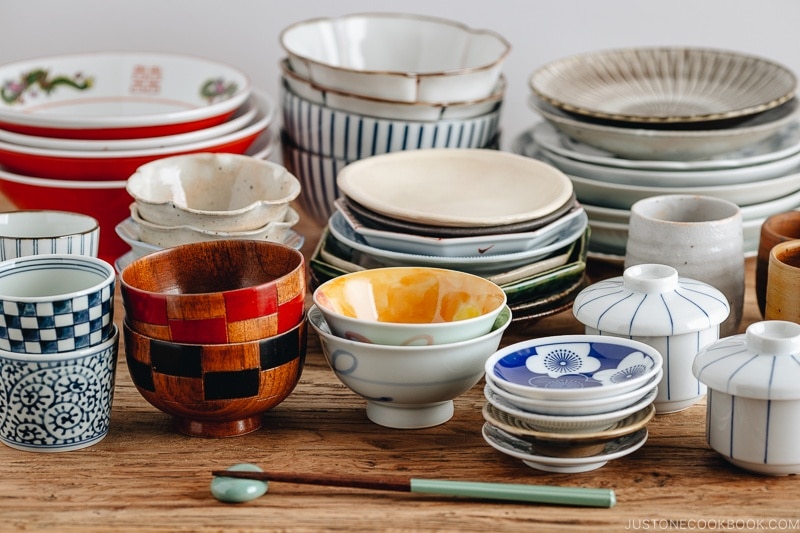
This is the ultimate guide to Japanese tableware and table set-up. You’ll learn about the important components (what bowls and plates to use, their sizes & functions), and table arrangement on how to set up a Japanese meal.
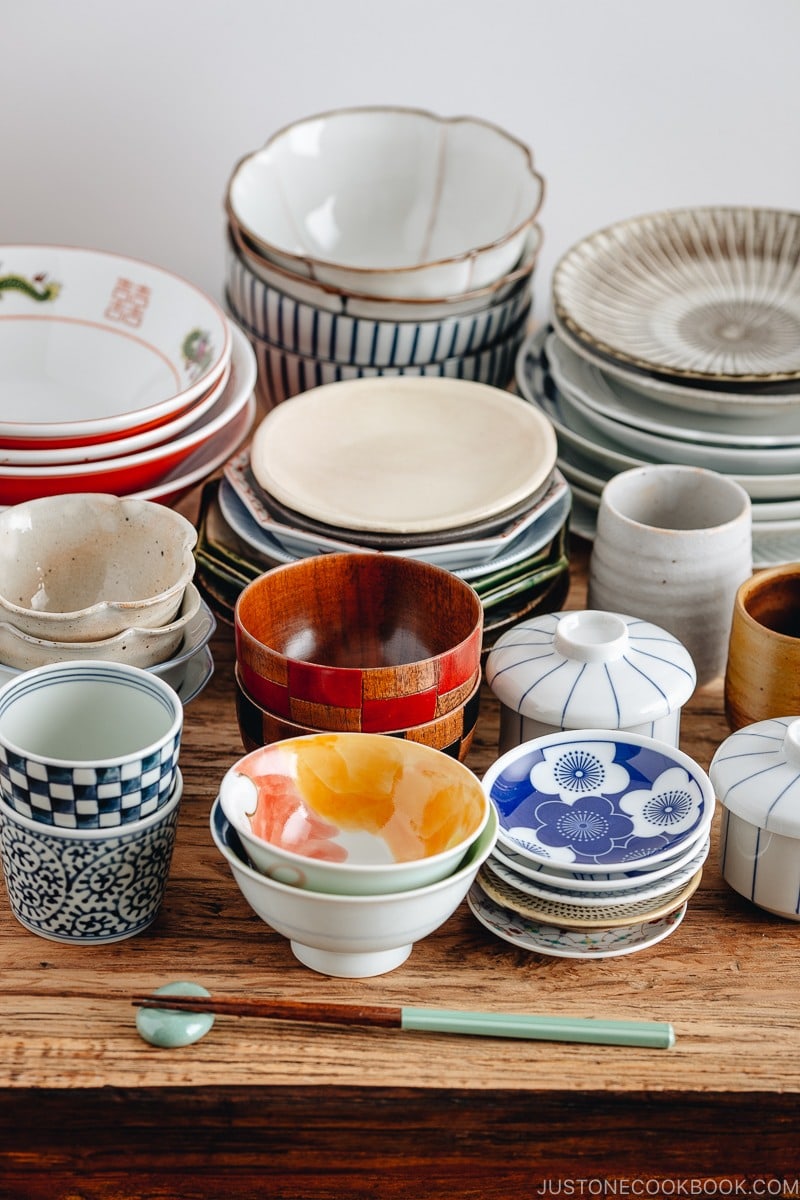
Are you interested in serving the Japanese meal (or known as Washoku 和食) in a traditional Japanese setting? Imagine re-creating the dining experience you’ve had from your memorable ryokan stay from your very own home? In this post, I’ll show you exactly what you will need for tableware to present a typical Japanese meal. I also included the measurements so you can find similar-size western plates and bowls if you have to use them.
Trust me, everyone can pull off a Japanese-style table setting with ease and confidence. Let’s get to it!
The Must-Have Japanese Tableware
![]()
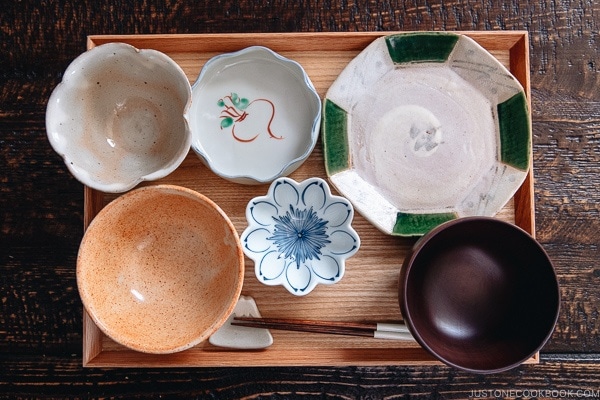
1. Rice Bowl (Ochawan or Chawan) お茶碗
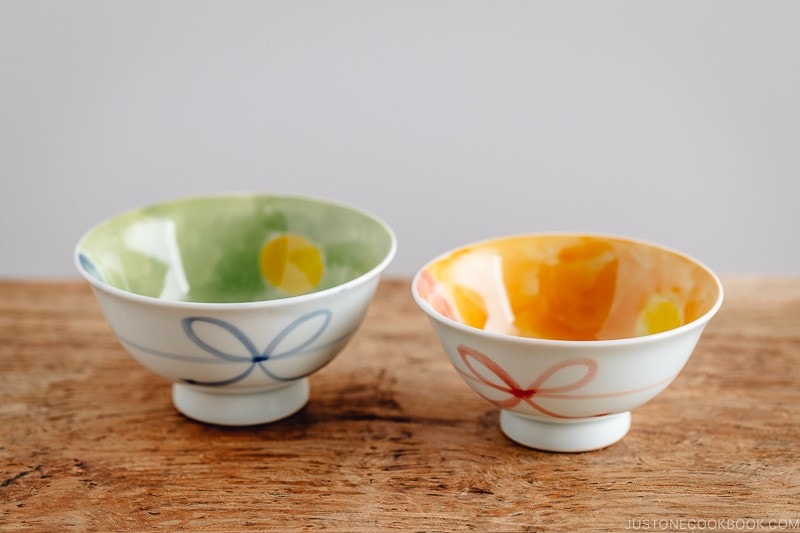
The most “personal” element among the Japanese tableware is the rice bowl. In Japan, each family member may have their own personal rice bowl dish with different sizes and materials. Dad may get a big ceramic rice bowl, mom may use a porcelain rice bowl with sakura pattern, the daughter may use a modern cat design rice bowl, and the son may use a character print on the rice bowl.
There is a couple rice bowl set called Meoto Chawan (夫婦茶碗). The husband gets the big bowl and the wife gets the smaller bowl. There are also rice bowls for children, while toddlers use plastic rice bowls (yes, Japanese toddlers can be picky and temperamental during mealtime too).
The concept here is about customization for personal liking, which I think makes the dining fun and intimate. Since Japanese cuisine focuses on seasonality, you may change up the bowls based on the seasons.
Size:
- 12 cm/4.7″ (4寸) in diameter, 6 cm/2.4″ in height, contains 150 g/5.3 oz of steamed rice.
- 11.4 cm/4.5″ in diameter, 5.7 cm/2.3″ in height, and contains 130 g/4.6 oz of steamed rice (for a female bowl of Meoto Chawan)
2. Soup Bowl (Shiruwan or Owan) 汁椀・お椀
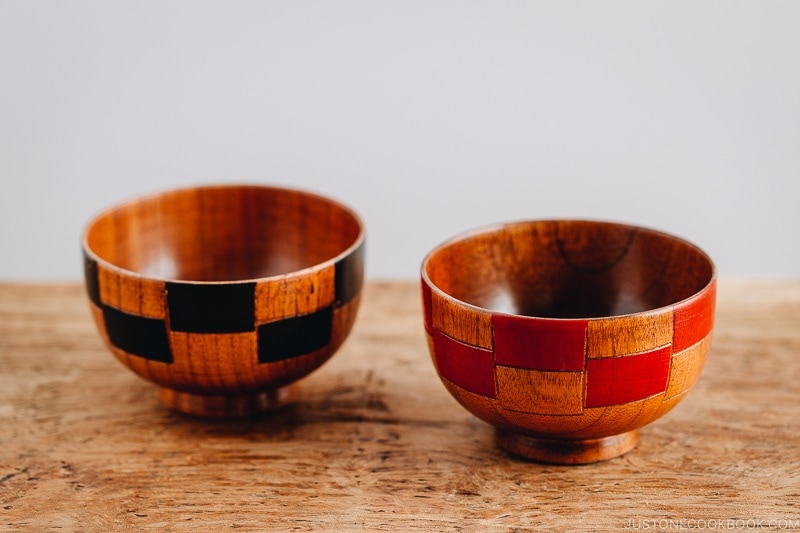
Since shiruwan or owan is used to serve hot soup, it is often made with the wooden material. Unlike rice bowls, everyone in the family typically uses the same type.
On a special day or holiday, soup is served in a shiruwan/owan with a lid. It is usually lacquered and has beautiful designs such as flowers.
Size:
- 12 cm/4.7″ (4寸) in diameter, 6 cm/2.4″ in height, contains 220-280 ml/roughly 1 cup of liquid.
3. Medium Plate (Chu-zara) 中皿
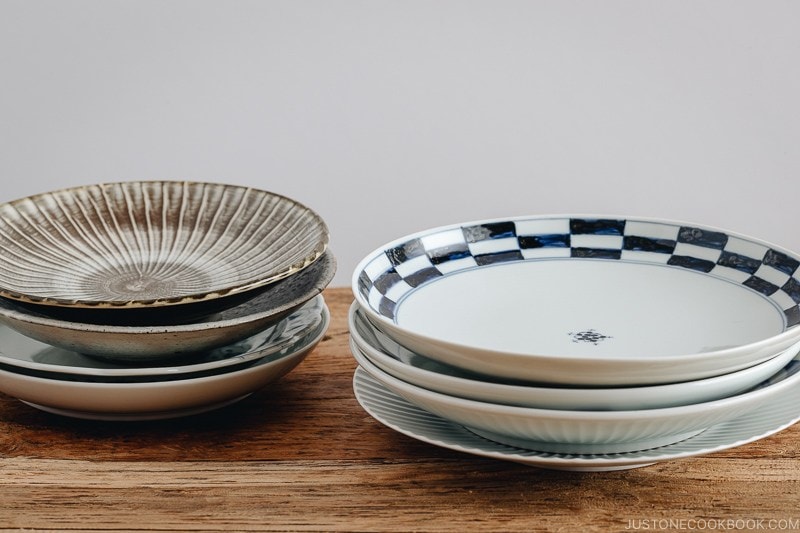
This plate is mainly used to serve the main dish (主菜). When you have a table with big serving plates and bowls in the middle, these medium plates can be used as an individual plate.
When used in a non-typical Ichiju Sansai setting, you can use this medium plate for a toast, etc.
This plate is very helpful so it’s nice to have variations of designs, shapes, and materials for different seasons and table settings.
Size:
- 21 cm/8.3″ (7寸皿) – A perfect dish for Ichiju Sansai’s main dish. A serving plate for a la carte.
- 18 cm/7″ (6寸皿) – A dish to fit Shokupan (Japanese pullman loaf). Good size for single serving salad and side dish.
Side Notes for Big Plate (Oh-zara 大皿):
- 30 cm/11.8″ (10寸皿・尺寸皿) – A serving platter for a big party, sashimi platter.
- 27 cm/10.6″ (9寸皿) – A serving platter for 4, great for plating ingredients for hot pot.
- 24 cm/9.4″ (8寸皿) – A one-plate dish for pasta and curry.
4. Small Plate (Ko-zara) 小皿
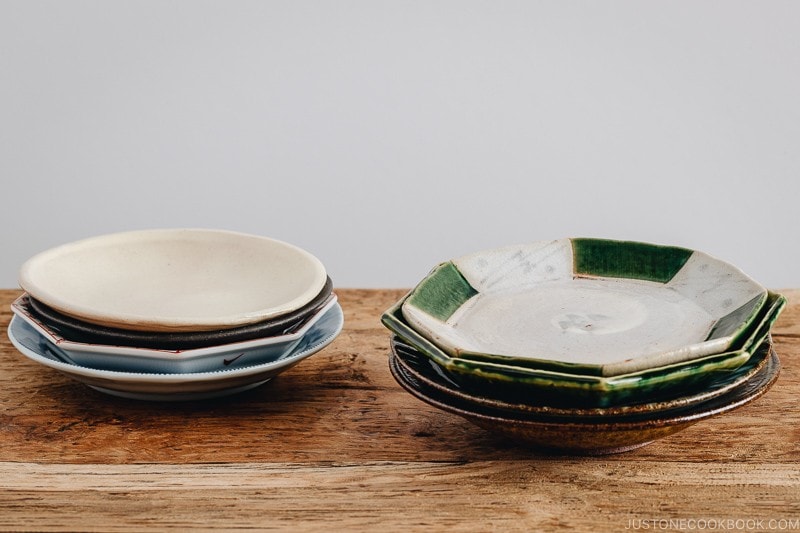
These small plates are perfect for side dishes, desserts, and snacks, or you can use them as an extra plate to share.
Smaller plates can be used as an accent for the table setting. Have fun collecting different colors and shapes to spice up your table.
Size:
- 15 cm/5.9″ (5寸皿) – Goof size for an extra plate to share or a slice of cake.
- 12 cm/4.7″ (4寸皿) – Good for small dishes like Cold Tofu, pickles, and Japanese sweets (wagashi).
5. Tiny Plate (Mame-zara) 豆皿
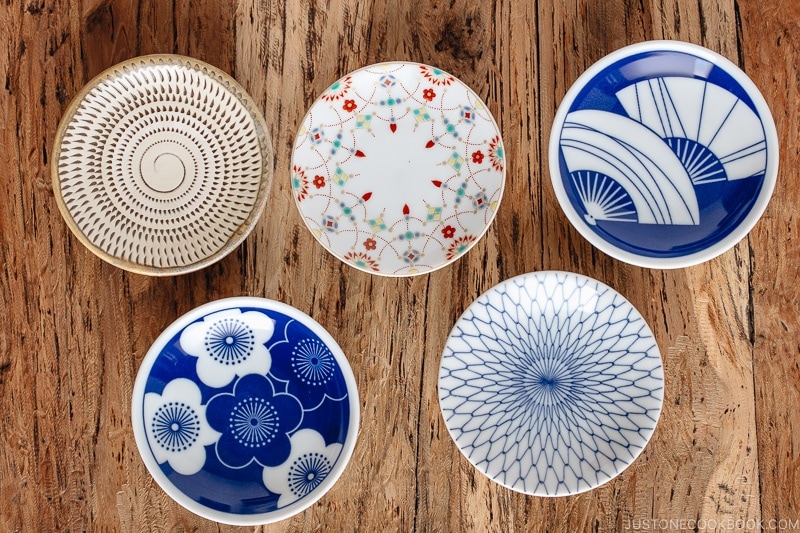
Mame-zara is used for soy sauce for sashimi, spice/condiments, or garnish (green onion, grated ginger) for Cold Soba, or small ingredient.
Size:
- 9 cm/3.5″ (3寸皿) – Good for bite-size dishes or condiments like soy sauce.
- 6 cm/2.4″ (2寸皿) – Good size for putting a garnish. It can be used as a chopstick rest.
6. Small Bowl (Kobachi) 小鉢
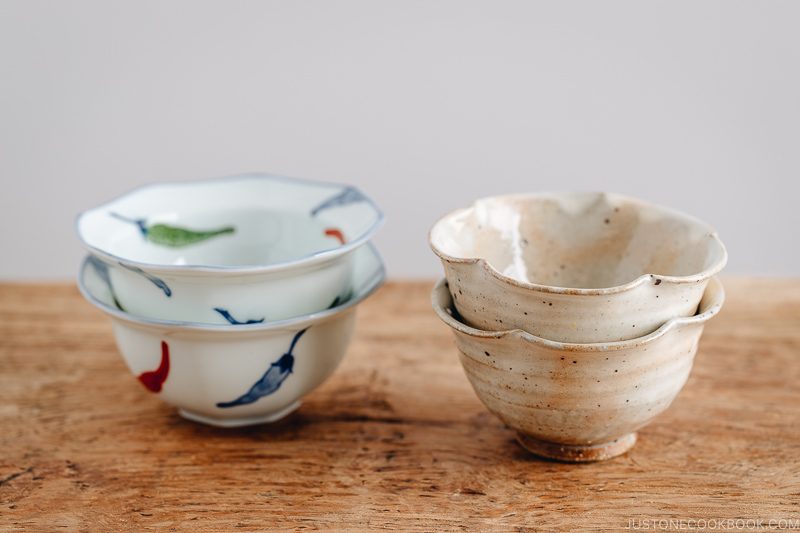
Kobachi is a small bowl normally used to hold Sunomono (vinegared salad), Aemono (dressed dish), Nimono (simmered dish), or Chinmi (special delicacies). It also can be used as an individual dish for hot pot.
There is no “specific” size for kobachi bowls, but there are three rough sizes listed here.
Size for Small Kobachi: Roughly 12 cm/4.7″ in diameter.
Side Notes for Medium & Big Kobachi Bowls:
- 15 cm/5.9″ (5寸) in diameter (Medium Bowl, 中鉢) – Perfect for a two-serving main dish (with soup/sauce) or single-serving soup and donburi dish.
- Roughly 22 cm/8.7″(7寸) in diameter (Big Bowl, 大鉢) – Perfect for a four-serving main dish (with soup/sauce) or single-serving noodle soup dish.
How to Set up the Table For Japanese-style Dining
Before setting up the table, it is helpful to understand the elements of a Japanese meal. Known as the Ichiju Sansai, a typical Japanese meal at home involves one rice with several side dishes and a soup. I included a more in-depth article on Ichiju Sansai for your reference.
The location of each dish is set for Ichiju Sansai: Steamed rice on the left front, and soup on the right front. Then the main dish is behind the soup, and side dish 1 is behind the steamed rice. Side dish 2 and pickles are located in the middle space.
Chopsticks & Chopstick Rest
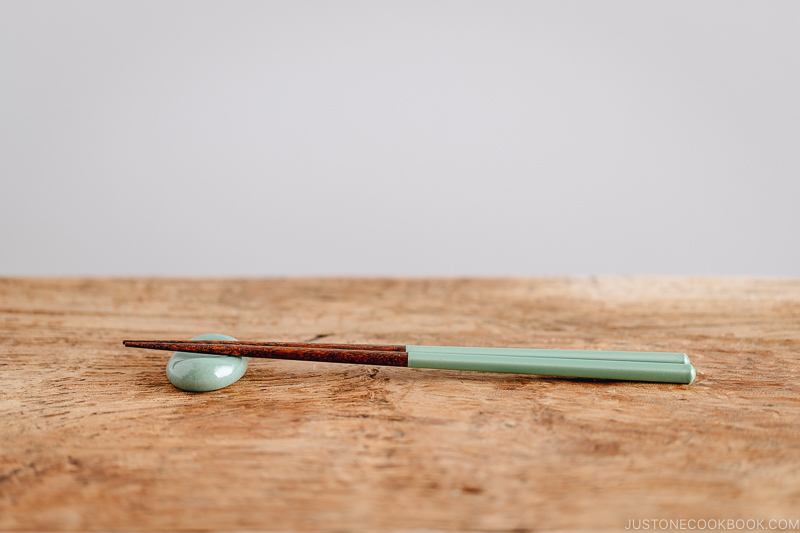
When you serve a meal in Japanese table setting, chopsticks and chopstick rests (hashioki) are a must-item. You may ask if chopstick rests are necessary. Well, chopstick rests are there for hygiene reason so the used chopsticks don’t touch the table. Plus, don’t you think they add a nice accent to the setting?
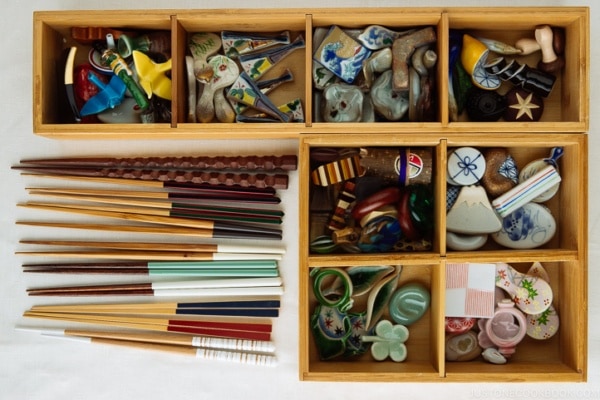
There are so many designs for chopsticks and chopstick rests, and it’s fun to collect them so you switch them up for different seasons and occasions.
Bonus: Nice-to-Have Tableware
These are not essential, but they are a great add-on for those of you who cook Japanese dishes regularly. If you have the kitchen space, you should consider getting them:
1. Rice/Noodle Bowl (Donburi) 5寸深丼
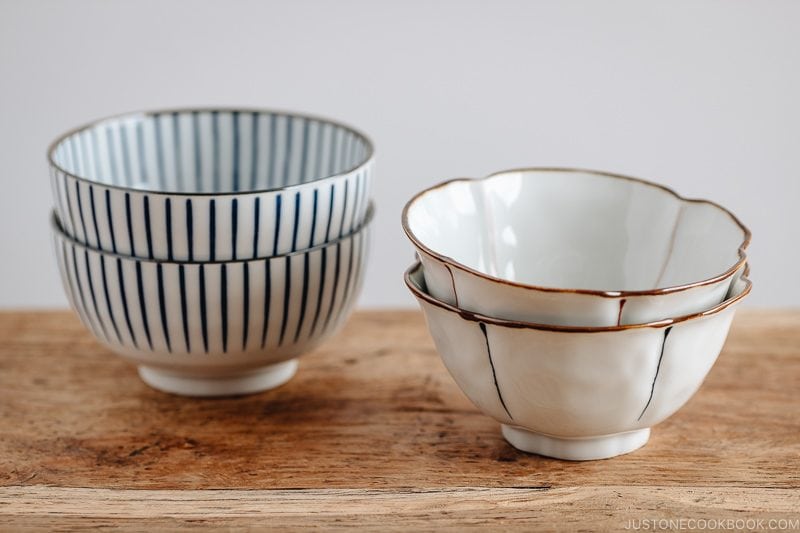
A large bowl used for soba or udon noodle soup as well as rice bowl (donburi) dish.
Size: 15 cm/5.9″ in diameter, 8.5 cm/3.3″ in height contains 900 ml.
2. Ramen Bowl (Ramen Bachi) ラーメン鉢
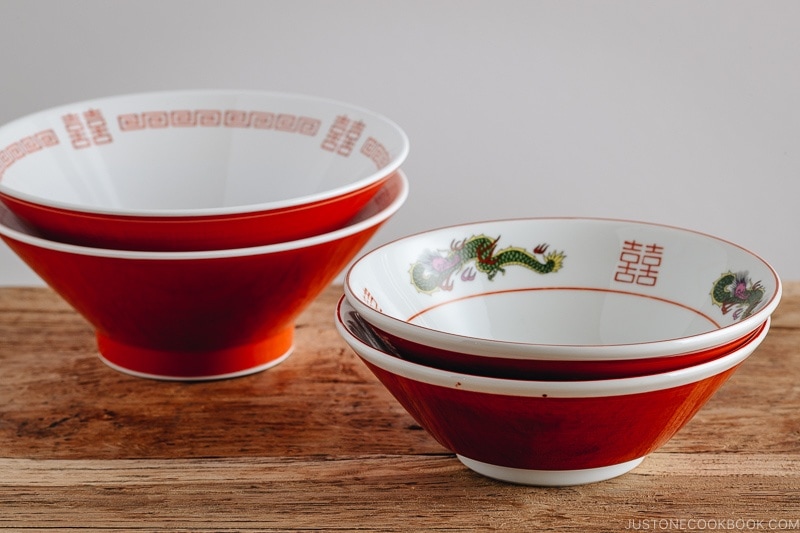
A large bowl used for ramen.
Size: 18 cm/7″ in diameter, 9.5 cm/3.1″ in height, contains 1400 ml.
3. Soba Dipping Dish (Sobachoko) 蕎麦ちょこ
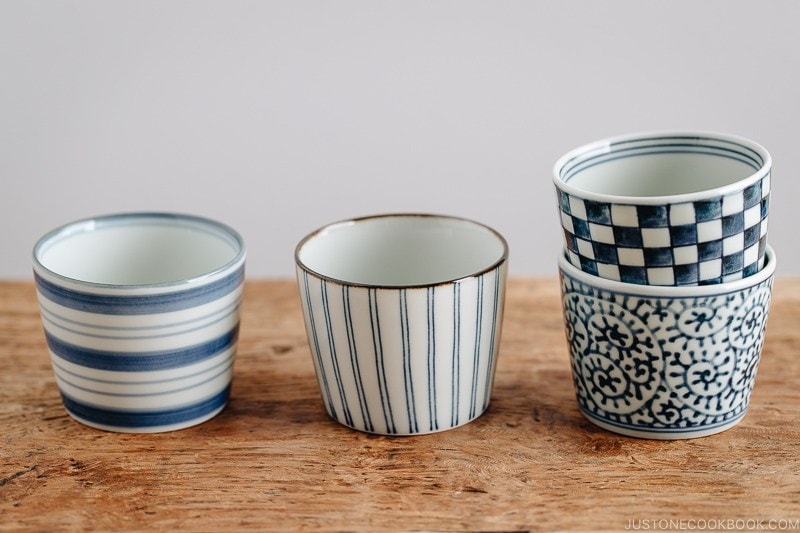
A tube-shaped dish used for soba dipping sauce and small dishes.
Size: 8 cm/3.1″ in diameter, 7 cm/2.8″ in height, contains 180-200 ml.
4. Steamed Cup (Mushi Wan) 蒸し碗
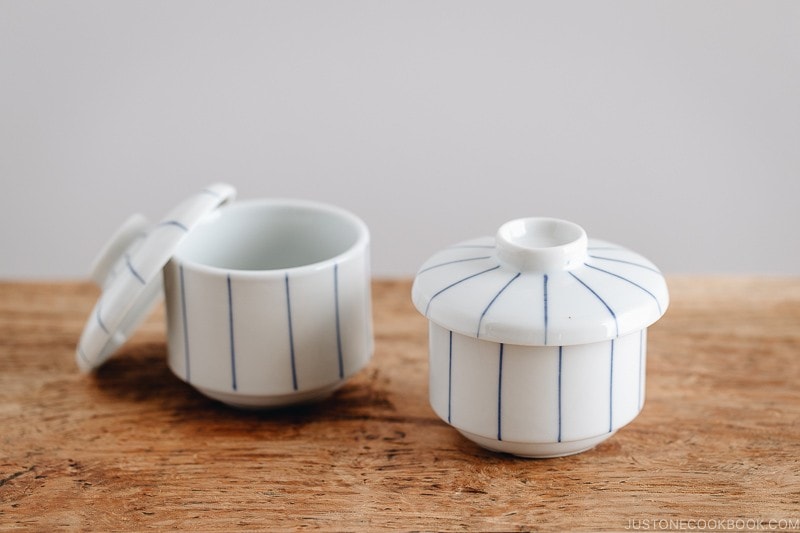
A cup designed for steaming, and comes with a lid. It’s used for dishes like chawanmushi.
Size: 8 cm/3.1″ in diameter, 8.5 cm/3.3″ in height, contains 200-230 ml.
5. Teacup (Yunomi Jawan) 湯呑み茶碗
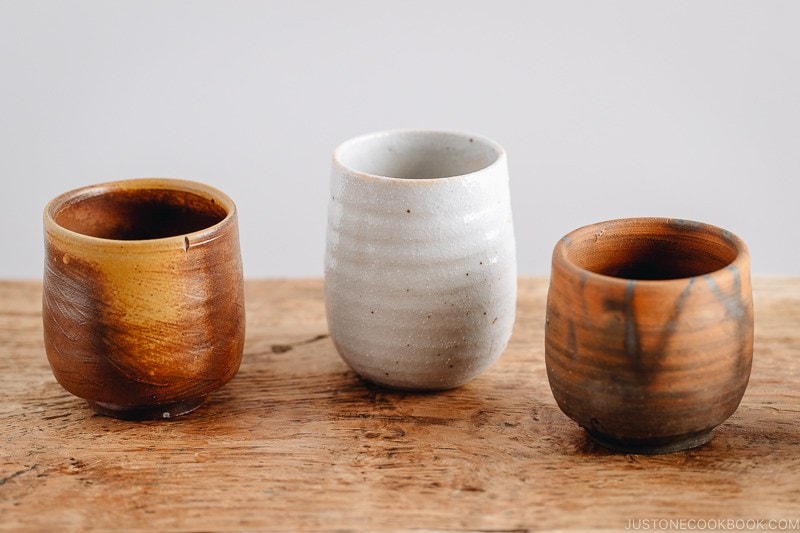
A cup used for Japanese green tea.
Size: The size varies depending on the occasion.
Measurement
Japanese tableware comes in various sizes and shapes, but they are guided by these measurements to create a well-balanced meal.
The measurement unit sun (寸) is used for Japanese tableware and it was introduced in the ancient history of Japan derived from measurements and proportions of the human body, collectively known as “Shindoshaku” (身度尺).
- 1分 = 0.1寸 = roughly 0.3 cm
- 1寸 = 10分 = roughly 3 cm
- 1尺 = 10寸 = roughly 30 cm
Additional Tips & Resources
1.Mix & Match – When comes to table set up, you don’t have to follow the strict rule of using only Japanese designed tableware. Some of the western-style plates and bowls can work to complement the table. Consider white or earth tones when choosing your colors. Handmade ceramic bowls and plates by your local artisans make an excellent choice too. You may be able to pick out designs that are very similar to Japanese tableware or in symmetry with Japanese elements.
2. Think harmony – In addition to colors, shapes, and textures, you will learn that the Japanese dining aesthetic places an emphasis on harmony. Which is what washoku 和食 all about. Everything has a place and purpose. When selecting your tableware, you don’t have to look for overly ornated choices but work on creating a balance to guide your artistic arrangement.
Where to Find Japanese Tableware outside of Japan?
Daiso and Muji are two major international Japanese stores that carry a wide selection of kitchen and dining items at affordable prices. If you are in the US, you can also look up World Market, cb2, Crate & Barrel or Etsy for Japanese-designed bowls and plates.
If you have the opportunity to visit Japan, check out my article on 10 Cookware & Tableware You Should Get from Japan.
With this, I hope you’re inspired to do a Japanese table set-up the next time you prepare a Japanese meal at home. And if you do, don’t forget to snap a picture and share it with #justonecookbook on Instagram. I’d love to see them!
Also, if you know where to find gorgeous Japanese tableware in your local area, share it with us in the comments below.
